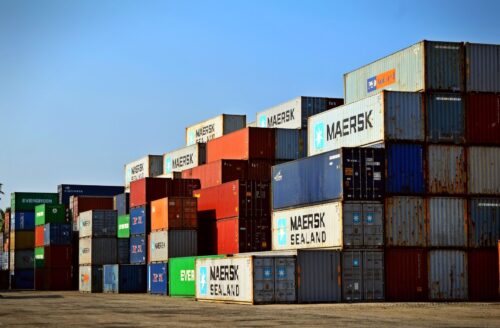4 Types of Logistics Management

Navigating the complex world of logistics management can be a daunting task for many businesses. Did you know different logistics types, such as inbound, outbound, reverse, and third-party logistics, play pivotal roles in creating an efficient supply chain?
In this article, you’ll learn about these four major types of logistics management and how they can streamline your operations, reduce costs and boost customer satisfaction. Let’s dive into the details to unlock the full potential of your business’s logistic operations.
Understanding the Dynamics of Logistics
Logistics management is a multifaceted process that’s vital to the supply chain. It involves planning, implementing, and controlling the flow of goods, services, and relevant information from their point of origin right through to the final destination. Also critical in this complex network are production management and customer service management.
All these elements interact constantly under an effective logistics management strategy with one key goal: delivering the right product to the right place at an optimum cost while exceeding customer expectations at every turn. Today more than ever before, businesses leverage strategic logistics operations in their quest for operational efficiency enhancement.
Effective Logistics Management Types Explained
Logistics management is vital for efficient and effective supply chain operations. By optimizing transportation, warehousing, inventory control, and other logistics processes, it enables businesses to minimize costs, maximize customer satisfaction, and gain a competitive edge in the market. There are four key effective logistics management types that help accomplish that.
Inbound Logistics
In the realm of logistics management, inbound logistics plays a pivotal role. This process centers on the efficient flow of goods and materials from suppliers to production facilities or warehouses.
Activities such as transportation management, inventory control, and supplier relationship management fall under this category. With successful implementation, inbound logistics can enhance operational efficiency and customer satisfaction while driving cost savings.
In essence, it’s an integral part of optimizing overall supply chain performance.
Outbound Logistics
Outbound logistics is a pivotal aspect of logistics management, focusing on transporting finished goods from a company’s production facilities to the consumers. This process entails order picking, consolidation, dispatching items, and delivering products to end customers.
Effective control over outbound logistics can lead to enhanced customer service and notable cost savings. Activities within this realm may encompass packaging and labeling, inventory management, transportation planning, and fostering robust customer relationships.
Reverse Logistics
Reverse logistics is a vital aspect of supply chain management that focuses on the efficient movement of goods from customers back to sellers or manufacturers. It involves processes such as managing returns, refurbishing or remanufacturing products, and dealing with unsold or end-of-life items.
By implementing effective reverse logistics strategies, businesses can reduce waste, recover value from returned products, and improve overall supply chain efficiency. This not only benefits the company but also contributes to customer satisfaction by ensuring seamless returns processes and proper handling of returned goods.
Third-Party Logistics (Fourth-Party and Green Logistics)
Third-party logistics (3PL) is a vital component of effective logistics management. These service providers focus on managing the day-to-day operations of supply chain logistics. They handle crucial functions like transportation, warehousing, and distribution on behalf of their clients.
Fourth-party logistics (4PL) is an advanced level of logistics management where a company outsources the entire supply chain management function to a strategic partner. The 4PL provider acts as an integrator, overseeing multiple 3PLs and other service providers to achieve streamlined operations, improved efficiency, and cost savings for their clients.
In addition to 3PL and 4PL, there is also a growing emphasis on green logistics services that prioritize sustainability and environmental responsibility in every aspect of the logistics process. Green logistics involve incorporating environmentally friendly practices and technologies to minimize the carbon footprint, reduce waste, and conserve natural resources.
The Logistics Management Cycle Defined

The logistics management cycle encompasses various crucial elements, including customer satisfaction and service, product handling, quantification attributes, inventory, and product turnover, information systems and technology, shipping timelines, and transit costs, as well as warehousing and stock.
Customer Satisfaction and Service: Shipping, Returns, Delivery
Customer satisfaction and service play a vital role in logistics management, particularly when it comes to shipping, returns, and delivery. Ensuring that customers receive their orders on time and in good condition is crucial for maintaining their loyalty and overall business success.
Efficient customer service includes providing a hassle-free return process with clear instructions and a return shipping label, making it easier for customers to send back unwanted or defective items.
Additionally, easy packaging for returns can also contribute to customer satisfaction by simplifying the process. Meeting these expectations helps build trust with customers while enhancing the overall experience of doing business with your company.
Product Handling
Product handling is a crucial aspect of logistics management that ensures the safe and efficient movement of goods throughout the supply chain. It involves activities such as loading, unloading, sorting, packaging, and storing products. In addition, it plays a key role in maintaining inventory accuracy, reducing damages and losses, and improving overall customer satisfaction.
By utilizing proper equipment, implementing standardized operating procedures, and training personnel on best practices, companies can streamline their product handling processes and achieve higher levels of operational efficiency.
With well-executed product handling strategies in place, businesses can minimize errors, improve order fulfillment speed, and ultimately enhance their profitability.
Quantification Attributes
Quantification attributes play a vital role in logistics management, helping businesses measure and evaluate various aspects of the process. These attributes provide valuable information about factors such as product demand, inventory levels, transportation costs, and delivery timelines.
By understanding these quantitative metrics, companies can make informed decisions to optimize their logistics operations for efficiency and cost-effectiveness. Analyzing quantification attributes allows businesses to identify areas for improvement and implement strategies that enhance overall supply chain performance.
Successful logistics management relies on accurate data analysis and continuous monitoring of these essential quantifiable factors.
Inventory and Product Turnover
Inventory and product turnover is a crucial aspect of logistics management that companies need to carefully monitor. It refers to the rate at which inventory is sold or used up and replenished.
Efficient inventory management ensures that products are not sitting idle in warehouses, tying up valuable resources and capital. By maintaining optimal inventory levels, companies can minimize costs associated with storage while also meeting customer demands in a timely manner.
Inventory turnover measures how quickly goods are being sold or used up, allowing businesses to identify slow-moving items or high-demand products that require additional attention.
Information Systems and Tech
In today’s digital age, information systems and technology play a crucial role in effective logistics management. From advanced tracking systems to real-time data analytics, technology has revolutionized the way businesses handle their supply chains.
Implementing state-of-the-art software and hardware allows companies to streamline processes, monitor inventory levels, optimize routes, and enhance overall efficiency. With the help of information systems and tech solutions, organizations can make informed decisions based on accurate data analysis, ultimately improving customer satisfaction while reducing costs along the entire logistics management cycle.
Shipping Timelines and Transit Costs
Shipping timelines and transit costs are crucial considerations in logistics management. The shipping timeline refers to the estimated time it takes for goods to be transported from one location to another, while transit costs refer to the expenses incurred during transportation.
Efficiently managing these factors is vital for businesses as it helps ensure timely deliveries and minimize unnecessary expenses. By carefully planning shipping schedules and optimizing transport routes, companies can enhance customer satisfaction by delivering products on time while also reducing logistical costs.
This proactive approach allows businesses to streamline their operations, achieve greater efficiency, and maintain a competitive edge in today’s fast-paced global market.
Warehousing and Stock
Warehousing and stock management play a crucial role in effective logistics management. Warehousing involves the storage and handling of goods, ensuring that they are stored safely and efficiently until they are ready to be shipped or distributed.
Stock management, on the other hand, focuses on activities such as stock monitoring, forecasting demand, replenishment planning, and maintaining optimal stock levels to meet customer demand while minimizing carrying costs and avoiding stockouts.
By implementing efficient warehousing practices and adopting effective stock management strategies, businesses can improve their supply chain processes, reduce delivery times, minimize product waste, and ultimately enhance customer satisfaction.
Types of Logistics Management and Profitability
Logistics management is essential for businesses to thrive in today’s competitive market. By effectively managing inbound, outbound, and reverse logistics, companies can optimize their supply chain operations, reduce costs, and exceed customer expectations. Furthermore, the growing emphasis on green logistics adds another layer of efficiency and sustainability to the logistics process.
FAQs
The following are some of the most frequently asked questions about logistics.
What are the 4 types of logistics?
The four types of logistics are inbound logistics, outbound logistics, reverse logistics, and third-party logistics (3PL) or fourth-party logistics (4PL).
What are the main types of logistics management?
The main types of logistics management include inbound logistics, outbound logistics, reverse logistics, and third-party logistics (including fourth-party and green logistics).
Final Words on Types of Logistic Management
In conclusion, understanding and implementing the various types of logistics management is crucial for businesses to ensure streamlined operations and customer satisfaction. Through effective inbound logistics, outbound logistics, reverse logistics, and third-party logistics, companies can optimize their supply chain processes and achieve higher profitability.
By utilizing modern technologies and efficient inventory management systems, businesses can enhance their logistical capabilities and meet evolving customer demands. Embracing these strategies will ultimately lead to improved cost reduction, increased operational efficiency, and greater success in today’s competitive market.

